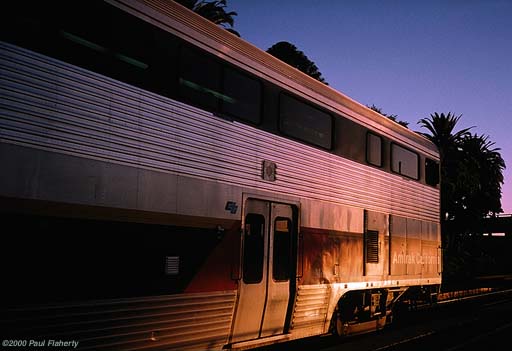
Amtrak San Joaquin at Stockton, California.
Olympus Stylus Epic, Kodak Ektachrome Extra 100

If you're just starting out in railfan photography, I'd recommend that you purchase a good quality point-and-shoot. These are simple, cheap cameras, and yet they produce excellent results. I particularly recommend the Olympus Stylus Epic , which has a fixed 35mm f/2.8 glass lens, yet is cheap enough ($99) to fit a student's budget. Take lots of pictures, look over them, see what you like the best. This will guide your decisions later on.
Your next step up should be a good used 35mm SLR. I'd suggest starting with a 50mm lens and an inexpensive body. Learn how to use the camera without the automation, using the light meter as a guide, taking your measurements off of a neutral gray body, such as track ballast. While both Canon and Nikon, the two most popular camera lines, have their advocates, the best optics are still manufactured by Carl Zeiss for the Contax brand. In fact, the Zeiss 50mm f/1.4, when combined with a high resolution film, such as Kodak T-Max 100, will actually outperform the equivalent Medium Format camera under average conditions.
With those two steps taken, and some experience, you should let your future purchases reflect your tastes.
Okay, what do I use? I have a Contax S2 mechanical body, with a 137MD as a backup. Lenses are Zeiss 50 f/1.4, 85 f/1.4, and 135 f/2.8. This setup reflects my preferences for no automation, high reliability, high resolution, and fast glass for sunrise and sunset shots, my personal favorites. I also carry an Olympus Stylus Epic for backup. My equipment is housed in Lowepro nylon bags, a Photorunner for the SLR, and an AF Mini for the point-and-shoot.